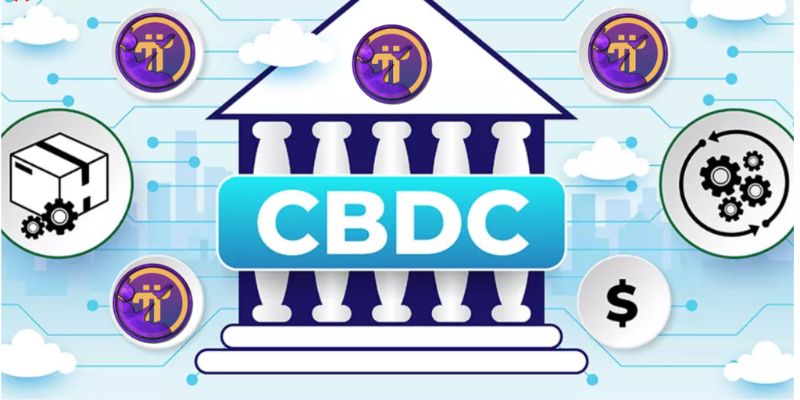Imagine a world where every dollar in your pocket is a blip on a screen, controlled not by a bank, but directly by the Fed. Welcome to the CBDC Revolution, a seismic shift in finance that could lead to CBDC and bank disintermediation. We’re on the brink of a new era where digital currencies promise ease but pose threats to the banking institutions we’ve long relied on. Could this lead to the end of traditional banking as we know it? Dive in as I unpack the reality behind this digital upheaval and what it means for your money.
Understanding CBDC Impact on Traditional Banking
The Shift in Financial Intermediation
Think about a bank. They stand between savers and borrowers, right? CBDCs change this. They let central banks reach us, no middleman. Banks worry. Here’s why: CBDCs make bank deposits less needed for payments. This means banks might have less money. Less money, less lending. Less lending? Smaller profits. And here’s the kicker – central banks don’t run out of money. So, is the banks’ role shrinking?
When a central bank offers digital cash, it’s not business as usual for banks. People might stash money in central banks, bypassing usual banks. CBDCs really shake things up. Still, don’t count banks out yet. They are crafty and know money. Sure, they might lose some cash. But they’ve been around for ages. They’ve got tricks up their sleeves to stay in the game.
To make it simple, CBDCs have money move digital. This tests how banks have worked for years. Some folks might skip banks and go straight to CBDCs. Banks have to figure out new ways to stay needed. They’re working hard on this, trust me.
Adapting Bank Business Models to CBDC Introduction
Alright, so things are changing, and fast. Banks can’t just sit and watch. They need fresh ideas to keep cash coming in. What’s the plan? Get creative with services. Think loans, investments, advice – areas where banks shine. CBDC might rule in payments. But banks will focus on what they do best, helping you with your dough.
Here’s the low-down: CBDCs push banks to find new edge. They need to be more than a spot to drop your cash. They’ve got to help you grow it, move it, protect it. Banks are used to ups and downs. They’ve seen tech shake-ups before. The smart ones will find a way to fit CBDC into their game plan.
Banks could offer things you can’t get from digital currency alone. Face-to-face chats, personal help, and more. That’s how banks want to stay in the picture. Even with CBDC, people need someone to talk to about money matters. That’s a card banks can play.
In short, CBDCs press banks to change. They have to prove they’re still worth a spot in your wallet. They’ve got to offer service with a plus – the human touch. Picture this: You’ve got CBDCs for day-to-day stuff. But for the big money moves? You might still look to your friendly bank. That’s how they plan to keep their spot at the table.

Disintermediation Risks in the Banking Sector
CBDC Adoption and the Threat to Bank Profitability
You might ask, “What is disintermediation?” Simply put, it’s when customers skip the middleman to go directly to the source. This is a big deal for banks because of CBDCs. CBDCs are like money, but digital. They’re made by central banks, the same folks who print our cash. Now, with CBDCs, customers might start to use them instead of regular bank accounts. This means banks could see less money coming in. And less money means less profit.
When banks make less money, they also lend less. Lending money is one way banks earn their keep. So, if banks do less lending, they become less important in the money world. CBDCs could snap up a slice of the banking pie. But they’re not the bad guys. They’re just new kids on the block that could shake things up. Banks aren’t going down without a fight, though.
How Banks Can Maintain Customer Relations in a CBDC Era
Staying chummy with customers will be a big test for banks when CBDCs crash the party. Banks have a game plan. They’re thinking about how to give us services and goodies that CBDCs can’t. For example, they can offer better interest rates or rewards. Or they can help us manage our money smarter.
Banks have a secret weapon: trust. Many people still trust banks to keep their money safe. They also trust them for advice on big money stuff, like buying homes. To keep this trust, banks need to get even better at what they do. They must be fast and easy to use, just like CBDCs. They also need to show they understand us and our money needs.
Banks could join hands with tech wizards to make banking apps that are really cool and easy to use. This way, they can show all the awesome things they can do that CBDCs can’t. It’s not over for traditional banks. Not by a long shot. They just have to roll up their sleeves and prove they’re still the champs of money management in this digital playground.

The Response of Commercial Banking to CBDC Disruption
Strategies for Traditional Banks to Counter CBDC Competition
Central banks are diving into digital money. It is a big deal for our wallets. Banks we know might change big time. They need new tricks to stay in the game. Banks help us save and get loans, but digital currencies from central banks can do this too. Banks must find fresh ways to add value or they risk losing us to these new digital options. But wait, banks are not giving up!
They’re creating better services, like giving advice on money and planning. They’re also putting tech to good use, connecting all their services together for us to use easily. Banks are playing a smarter game – using data to figure out what we need before we even ask. They’re making sure banking with them feels personal, and that might just keep us coming back.
The Evolution of Payment Systems and Bank Services
When we talk about money today, it’s less about coins and notes. It’s more about swiping, tapping, and clicking. CBDC changes how we think of money. The old way banks handle payments is getting a tech boost. Money moves faster and cheaper with CBDCs. For example, sending money to a friend used to take days, but now it’s instant.
Banks are stepping up their game because of this. They are mixing new payment ways with their classic banking. That means, beyond the usual ATM or credit card, we can use phones or even watches to pay. It kind of levels the playing field with digital currencies from central banks. And let’s be honest, it’s pretty cool too.
Banks know they have to keep us happy to stick around. They are making paying bills less of a headache, and helping businesses big and small get paid easier. The way banks are changing, it might feel like they’re turning into our money helpers, not just a place to stash our cash.
Banks are also getting serious about being safe online. So even when money goes digital, they make sure it’s like a vault. We can rest easy knowing our digital dollars are under lock and key.
So, even as central banks step up with digital currencies, your familiar bank is not just watching. It’s changing, giving us new reasons to stay loyal. With every swipe, tap, and click, they’re fighting to keep their spot in our wallets. And who wins? We do, with more options and better banking.

Regulatory Framework and the Future of Digital Currencies
Balancing Regulation with Innovation in the Age of CBDCs
New digital money from central banks is shaking things up. Banks worry. They face big changes. Digital cash means new ways to handle money. Banks must follow rules while trying to keep up. Tough job, right?
What does CBDC impact on banks? It makes them rethink how they do all things money-related. They must keep up with tech while following new rules. Banks now face a race. It’s a race to stay useful as central banks bring out their digital currencies. They must ask, “How do we stay helpful to our customers?”
The effects of digital currency on financial institutions are huge. Banks are thinking hard about their next moves. With regulations shifting, staying in line is key. Banks must be fair. They also must keep their services top-notch for customers. It’s about finding that sweet spot. It’s mixing the old bank ways with new digital moves.
For central banks, they must set up rules that spur growth. But they have to protect users, too. Tough balance, no doubt. We’re talking safe, fair, and cutting-edge. Those are the big goals.
Rules guide how banks and digital money will work together. Doing it right means banks play fair and stay true. Get it wrong? They could lose their spot. People might say, “We don’t need banks like before.”
Digital currency is a game-changer. Banks must adapt or risk falling out of the race.
Blockchain Technology and Its Role in Shaping Central Bank Digital Currencies
Okay, so blockchain is this tech that supports digital cash. It’s like a digital ledger. Think of it as a notebook that keeps track of everything. All safe and sound. It’s super vital for this whole digital money thing.
Banks are looking at blockchain. They think, “How can we use this?” Blockchain could change how they work. It makes things faster and more open. But banks have to learn new tricks. They got to get it right to keep customers smiling.
CBDCs are built on blockchain technology. This means super secure and speedy money moves. Banks get why it’s cool. They see new ways to serve people. It’s all about fast, safe and easy services. That’s the win.
Blockchain is making the money world exciting. Banks must jump on this too. They got to change their old ways. It’s like learning to ride a new bike. A super-fast, high-tech bike.
The future? It’s banks using blockchain to stay in the game. They want to make things better for all of us. But they’ve got to keep it real with rules. It’s all about being fair while bringing fresh ideas to life.
So yes, digital money is here. Banks must roll with it. They’ve got to keep the trust and bring the new cool. The goal? To make sure we all get to enjoy safe, fast, and easy money moves. It’s about growing with care. The future looks bright when we get the mix just right.
In this post, we dove into how central bank digital currencies, or CBDCs, are shaking up traditional banking. We explored the shift in financial work and how banks need to change their game to stay in the race. We also looked at the risks banks face, like losing money and their grip on customers. But it’s not all doom and gloom. Banks can fight back with smart moves and new-fangled payment and service ideas.
We wrapped up with a peek at rules for the road ahead and the tech that will pave the way. Remember, CBDCs are a big deal and they’re reshaping money as we know it. Banks must flex and adapt or risk getting left behind. Stay sharp, be ready to switch gears, and keep an eye out—banking’s next chapter is just around the corner. And it’s packed with action!
Q&A :
What is a CBDC and how could it lead to bank disintermediation?
Central Bank Digital Currency (CBDC) refers to a digital form of a country’s national currency that is issued and regulated by the country’s central bank. The introduction of a CBDC could potentially lead to bank disintermediation by allowing individuals to hold accounts directly with the central bank, reducing the need for traditional commercial bank accounts and services.
How might CBDCs impact the traditional banking system?
CBDCs could significantly impact the traditional banking system by altering the way deposits and payments are handled. If consumers opt to hold their funds as CBDCs rather than in bank deposits, banks could face a decrease in their deposit bases, which are crucial for lending activities. This could affect the profitability of banks and change the dynamics of credit creation within the economy.
Can CBDC replace traditional banking services?
While CBDC has the potential to replicate certain services provided by traditional banks, such as secure storage of funds and transaction processing, it may not fully replace all banking services. Traditional banks offer a suite of financial services including loans, credit facilities, and investment products that may not be directly covered by a CBDC system.
Will CBDCs require a new regulatory framework to ensure stability in the financial system?
The implementation of CBDCs will likely necessitate the development of a new regulatory framework to manage risks associated with digital currencies and ensure stability in the financial system. Central banks and regulatory authorities may need to establish rules for the interoperability with existing payment systems, anti-money laundering (AML) compliance, and consumer protection.
How could consumer behavior impact the success of CBDC implementation?
Consumer adoption and trust are critical for the success of CBDC implementation. If consumers are hesitant to use CBDCs due to concerns about privacy, security, or convenience, this could hamper their widespread acceptance and integration into everyday financial activities. Effective communication and robust technological infrastructure are essential to encourage consumer buy-in.

